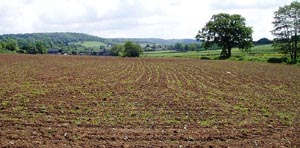Birdcombe
ANCIENT NAILSEA: BIRDCOMBE MESOLITHIC SITE
The history of Nailsea and its surroundings is much more ancient than many of us can image.
The earliest evidence we have of human activity was found at Birdcombe (ST475718 - Click Here for OS map or Click Here for Flash Earth satellite photo) and this material dates back to the Mesolithic era. The Mesolithic era, or Middle Stone Age, refers to the time from the end of the last ice age to the beginning of farming and making pottery. Mesolithic people were hunter gatherers, nomadic and used tools make of stone, flint and antlers.

The site at Birdcombe, just to the north of Nailsea, lies at the bottom of a slope facing south across the Land Yeo River. Above the site are the limestone hills of the Failand Ridge, and the site sits adjacent to the present day Towerhouse Wood. There are several sprins in the area as well as the Land Yeo and the coast is only 5 miles away.
The site was discovered when worked flints (pieces of flint that have been broken or knapped to create sharp edges that can be used as tools either individually or by binding several smaller pieces to antlers or wood), were discovered after ploughing in 1952. An archaeological excavation was then undertaken by C M Sykes and SL Whittle which revealed hundreds of pieces of worked flint, along with cores of flint, scrapers, and microliths. They also found a piece of wood tar which was used to attach microliths onto a shaft.
There was a second excavation undertaken by Paula Gardiner of Bristol university in 1997 where over 1600 pieces of worked flint were found.
The evidence from both excavations show no signs of permanent settlement but they did show that the area was used over a considerable period of time and estimated that the occupation of the site by Mesolithic people was around 6,000 years ago.
Although there are Mesolithic artefacts to be found in many parts of North Somerset, this is the only significant occupation site. There are also some well known sites on the Mendips. The most famous discovery is of course Chedder Man the remains of whom was found in the early 20th century and recent DNA testing suggest that his ancestors still live in the Chedder region.
The site at Birdcombe must have been an attractive one to the hunter gathers as it benefits from both upland and lowland geography and the wide variety of food sources from the flora and fauna that result from that. Evidence of Roe and Red dear appear in most Mesolithic settlement sites and the deer themselves prefer upland woods in the summer and lowland clearings in the winter suggesting that Birdcombe would have provided an ideal wooded emcampment.
Paula Gardiner suggests that the Failand Ridge may have provided the more permanent settlements in caves with Birdcombe providing a more seasonal camp which may even have provided a meeting place for various hunting groups from the Mendips.
Nailsea is very fortunate to have many historical and natural history treasures that we walk and drive past every day. Next time you drive out from Nailsea along the Wraxall Road, look to your left towards Towerhouse Wood and see where humans lived 6000 years ago.
For further and more detailed information please see the archaeological writings on Bridcombe by Sykes & Whittle and by Paula Gardiner.
C M Sykes and S L Whittle (1960). The Birdcombe Mesolithic Site, Wraxall in Proceedings of the Somerset Archaeological and Natural History Society Vol 104, pp106-122
Gardiner, P.J. 2000. "Excavations at Birdcombe, Somerset: Mesolithic Settlement, Subsistence and Landscape Use in the South West of England", in R. Young (ed) Mesolithic Lifeways. Current Research from Britain and Ireland. Leicester Archaeology Monographs No.7, University of Leicester, pp119-207.
